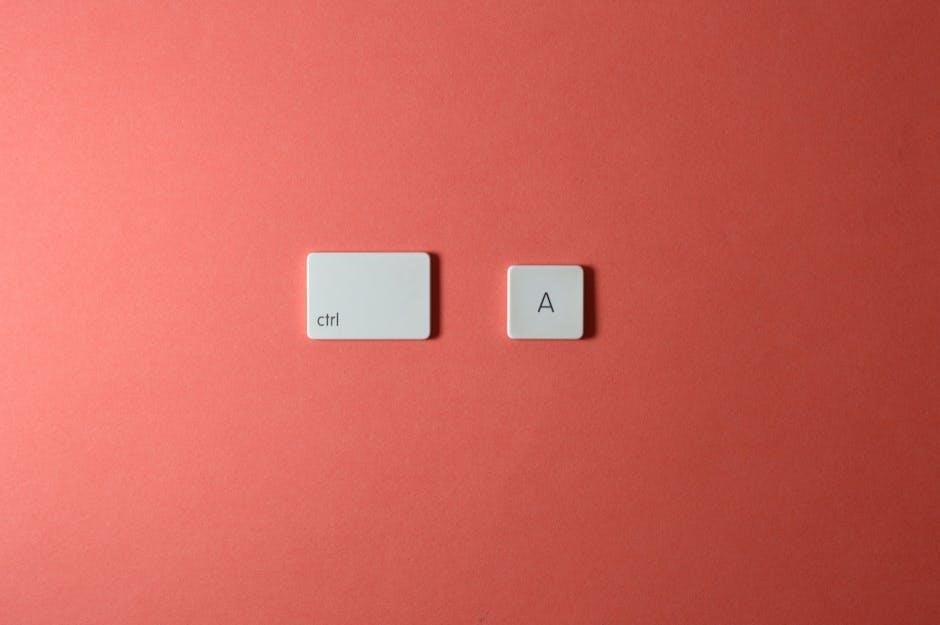The Nikon D500 is a 20.9 MP DSLR with a CMOS sensor, designed for enthusiasts and professionals. It offers fast autofocus, 10fps shooting, and advanced metering. The instruction manual is essential for mastering its features and settings, ensuring optimal performance in various photography scenarios.
1.1 Key Features of the Nikon D500
The Nikon D500 boasts a 20.9 MP CMOS sensor, offering excellent image quality and low-light performance. It features a wide ISO range of 100-51200, fast 10fps continuous shooting, and an advanced 153-point autofocus system. The camera supports 4K video recording at 3840 x 2160 pixels and includes built-in Wi-Fi, Bluetooth, and NFC for seamless connectivity. Dual memory card slots provide storage flexibility, and the 3.2-inch touchscreen LCD enhances usability. These features make the D500 a powerful tool for both photography and videography, catering to enthusiasts and professionals alike.
1.2 Importance of the Instruction Manual
The Nikon D500 instruction manual is essential for understanding and mastering the camera’s advanced features. It provides detailed guidance on setup, customization, and troubleshooting, ensuring users can optimize their photography experience. The manual covers key functions like autofocus modes, metering systems, and video settings, helping photographers of all levels make the most of the D500’s capabilities. Available in PDF format, it offers convenient access across devices, making it an indispensable resource for unlocking the camera’s full potential and achieving professional-grade results.

Unboxing and First Impressions
The Nikon D500 arrives with a comprehensive manual, charged battery, strap, and body cap. Its solid build and professional feel immediately impress, hinting at its advanced capabilities.
2.1 What’s Included in the Box
The Nikon D500 box includes the camera body, a rechargeable Li-ion battery (EN-EL15), a battery charger (MH-25a), a neck strap, and a body cap. Additionally, the package contains the instruction manual, which is available in multiple languages, including English. The manual provides detailed guidance on camera operation, settings, and troubleshooting. No lenses are included in the standard package, but the camera is compatible with a wide range of Nikon lenses. The box also includes a warranty card and a quick start guide for initial setup.
2.2 Initial Setup and Battery Charging
Start by charging the EN-EL15 battery using the provided MH-25a charger. Allow it to charge fully before first use. Insert the battery into the camera, ensuring it clicks securely into place. Turn on the camera and follow the on-screen prompts to set the language, date, and time. Refer to the manual for detailed instructions. The camera is now ready for initial configuration. Ensure the firmware is up to date for optimal performance. This setup process ensures your Nikon D500 is prepared for capturing high-quality images right away.
Getting Started with the Nikon D500
Begin by charging the battery, inserting it, and powering on the camera. Use the manual to guide you through initial settings like language, date, and time. Ensure firmware is updated for optimal performance.
3.1 Basic Camera Controls and Layout
The Nikon D500 features an intuitive layout with controls designed for quick access. The top panel includes the mode dial, ISO button, and shutter release. The rear panel houses the WB button, AF Mode button, and command dial for adjusting settings. The camera’s ergonomic design ensures comfortable handling, with key buttons like the info button and live view switch conveniently located. Familiarizing yourself with these controls is essential for efficient operation and capturing high-quality images. The manual provides detailed explanations to help you master the camera’s layout and functionality.
3.2 Initial Camera Configuration
Setting up your Nikon D500 begins with navigating through the menu system. Start by configuring basic settings like date, time, and language. Set your image quality preferences, choosing between JPEG, RAW, or TIFF formats. Familiarize yourself with the autofocus modes and metering options. Customize white balance settings to suit your shooting conditions. The manual guides you through these initial configurations, ensuring your camera is optimized for your photography style. Proper setup is crucial for achieving the best results and streamlining your workflow.

Understanding the Camera’s Layout
The Nikon D500 features a 3.2-inch touchscreen LCD, weather-sealed body, and intuitive button placement. Its ergonomic design includes dual SD card slots and a tilting LCD for versatility.
4.1 Top Panel Controls
The Nikon D500’s top panel features essential controls for quick access during shooting. The ISO button adjusts sensitivity, while the mode dial selects shooting modes like PASM or Auto. The exposure compensation button fine-tunes brightness, and the metering mode button switches between Matrix, Center-Weighted, Spot, or Highlight-Weighted modes. The main command dial adjusts shutter speed or aperture, depending on the mode. These controls are strategically placed for intuitive operation, allowing photographers to make adjustments without missing a shot.
4.2 Rear Panel and Button Functions
The rear panel of the Nikon D500 is equipped with a 3.2-inch touchscreen LCD for image review and menu navigation. Key buttons include the playback button for reviewing images, the menu button to access camera settings, and the OK button for selecting options. The zoom in and zoom out buttons allow for detailed image inspection. Additional controls like the focus mode and white balance buttons enable quick adjustments. The info button toggles LCD information displays, while the delete button removes unwanted images. These buttons streamline operation and enhance customization during shooting.
4.3 Mode Dial and Shooting Modes
The Nikon D500 features a mode dial on the top panel, offering various shooting modes to suit different photography needs. The Auto Mode is ideal for beginners, automatically adjusting settings for optimal results. The PASM Modes (Program, Aperture Priority, Shutter Priority, Manual) provide advanced control over exposure. Scene Modes like Portrait and Landscape optimize settings for specific genres. Additionally, the U1 and U2 settings allow users to save and recall custom configurations, enhancing workflow efficiency and creativity during shoots.
Shooting Modes Explained
The Nikon D500 offers multiple shooting modes, including Auto, Scene, PASM (Program, Aperture Priority, Shutter Priority, Manual), and User Settings (U1, U2), catering to diverse photography needs and skill levels.
5.1 Auto Mode and Scene Modes
The Nikon D500’s Auto Mode simplifies photography by automatically adjusting settings for optimal results. Scene Modes, such as Portrait, Landscape, Sports, and Close-up, tailor settings to specific situations. Auto Mode is ideal for beginners or quick shots, while Scene Modes enhance creativity by optimizing parameters like aperture, shutter speed, and ISO for desired effects. These modes ensure sharp action in Sports Mode, vibrant colors in Landscape Mode, and flattering portraits with blurred backgrounds, making them versatile tools for capturing diverse subjects with ease and precision.
5.2 PASM (Program, Aperture Priority, Shutter Priority, Manual) Modes
PASM modes offer advanced control over the Nikon D500. Program Mode provides automatic settings with user adjustments. Aperture Priority (A/Av) controls depth of field, while Shutter Priority (S/Tv) manages motion effects. Manual Mode (M) allows full control over aperture, shutter speed, and ISO for precise results. These modes cater to experienced photographers, enabling creative freedom and technical precision in various lighting conditions and artistic expressions, ensuring optimal image capture tailored to individual vision and style.
5.3 U1 and U2 User Settings
The Nikon D500 features U1 and U2 user settings, allowing photographers to save and quickly recall custom shooting configurations. These settings, accessible via the mode dial, enable rapid adjustments to ISO, white balance, autofocus, and other parameters. U1 and U2 are ideal for photographers who frequently switch between different shooting scenarios, such as switching from portraits to landscapes or adjusting for varying lighting conditions. This feature enhances workflow efficiency and ensures consistent results by saving personalized preferences for instant access, making it a powerful tool for tailored photography experiences.

Autofocus System and Metering
The Nikon D500 boasts a fast, effective autofocus system and first-rate metering, ensuring precise focus and accurate exposure control for optimal image quality in various conditions.
6.1 Autofocus Modes and Customization
The Nikon D500 features advanced autofocus modes, including Single AF, Continuous AF, and Manual Focus. Users can customize autofocus settings via the AF Mode button and command dial. The camera allows for precise control over focus acquisition, enabling photographers to tailor autofocus behavior to their shooting style; Customization options enhance responsiveness and accuracy, ensuring sharp images in dynamic situations. These features make the D500 ideal for capturing fast-moving subjects and achieving professional-grade focus control.
6.2 Metering Modes (Matrix, Center-Weighted, Spot, Highlight-Weighted)
The Nikon D500 offers four metering modes: Matrix, Center-Weighted, Spot, and Highlight-Weighted. Matrix metering provides balanced exposure by analyzing the entire scene. Center-Weighted prioritizes the subject in the center, ideal for portraits. Spot metering measures light from a small area, useful for high-contrast scenes. Highlight-Weighted ensures bright areas are preserved, preventing overexposure. These modes allow photographers to adapt to various lighting conditions, ensuring accurate exposures tailored to their creative vision.
Image Quality and White Balance
The Nikon D500 delivers exceptional image quality with an ISO range of 100-51200, minimizing noise in low-light conditions. White balance options include auto, presets, and custom settings for precise color accuracy. The camera supports JPEG, RAW, and TIFF formats, ensuring flexibility in post-processing and maintaining high image fidelity.
7.1 ISO Sensitivity and Noise Reduction
The Nikon D500 features an ISO sensitivity range of 100 to 51200, enabling excellent performance in both bright and low-light conditions. The camera effectively minimizes noise, even at higher ISO settings, ensuring crisp and detailed images. Noise reduction settings can be customized to balance detail retention and smoothness, allowing photographers to tailor the output to their creative needs. This flexibility makes the D500 versatile for capturing sharp, high-quality images across a wide range of lighting scenarios.
7.2 White Balance Settings and Custom Options
The Nikon D500 offers precise white balance control to ensure accurate color representation. Users can adjust white balance by pressing the WB button and using the command dial to select from options like Auto, Cloudy, Direct Sunlight, Flash, Fluorescent, and Incandescent. For custom needs, the PRE option allows manual measurement using a neutral reference object. This feature is particularly useful for capturing consistent colors in specific lighting conditions, enhancing overall image quality and reducing post-processing time. The D500’s white balance system is both intuitive and flexible, catering to various photographic scenarios.
7.3 File Formats (JPEG, RAW, and TIFF)
The Nikon D500 supports three primary file formats: JPEG, RAW, and TIFF. JPEG is ideal for sharing and storage, offering compressed files with minimal loss in quality. RAW files capture all image data, providing maximum flexibility for post-processing. TIFF is an uncompressed format, delivering high-quality images with larger file sizes. Each format serves different needs, allowing photographers to choose based on their workflow and desired output. The D500’s flexibility in file formats ensures compatibility with various editing software and printing requirements, catering to both professionals and enthusiasts.

Exposure and Flash Settings
The Nikon D500 offers precise exposure control with compensation and bracketing options. It features a built-in flash and supports external flash units for enhanced lighting flexibility.
8.1 Exposure Compensation and Bracketing
The Nikon D500 allows for precise exposure control through compensation and bracketing. Exposure compensation adjusts brightness in ±5 EV increments, accessed via the dedicated button and command dial. Bracketing captures up to 7 frames at varying exposures, ideal for high-contrast scenes. This feature is particularly useful for HDR photography, ensuring a wide dynamic range. The camera also supports flash exposure compensation, enabling balanced lighting in challenging conditions. These tools provide flexibility for capturing images with optimal exposure, even in difficult lighting scenarios.
8.2 Built-in Flash and External Flash Options
The Nikon D500 features a built-in flash with a guide number of 12m/39ft at ISO 100, offering modes like Auto, Red-eye reduction, Second curtain synchro, and Slow synchronization. For enhanced lighting, the camera supports external flash units via the hot shoe or wireless commander mode. The built-in flash can also control external Speedlights in Nikon’s Creative Lighting System (CLS), enabling advanced wireless lighting setups. This flexibility allows photographers to achieve professional-grade lighting effects in various shooting scenarios, ensuring well-lit and balanced images.

Video Recording and Playback
The Nikon D500 offers 4K video recording at 3840 x 2160 pixels with frame rates up to 30fps. Playback features include single images, slide shows, and highlights.
9.1 Video Resolution and Frame Rates
The Nikon D500 supports 4K video recording at 3840 x 2160 pixels, with frame rates of 24fps, 25fps, and 30fps. It also offers Full HD recording at 1920 x 1080 pixels with frame rates of 24fps, 25fps, 30fps, 50fps, and 60fps. Additionally, the camera can record HD video at 1280 x 720 pixels. These resolutions and frame rates provide flexibility for capturing cinematic footage or smooth motion, making the D500 versatile for both photography and videography. The instruction manual details how to adjust these settings for optimal video quality.
9.2 Focusing During Video Recording
The Nikon D500 offers advanced focusing options during video recording. It supports Single AF and Continuous AF modes, allowing precise subject tracking. The AF Mode button enables quick switching between modes, while the command dial adjusts settings. Face detection and subject tracking enhance focus accuracy, ensuring sharp footage. The instruction manual provides detailed guidance on optimizing autofocus for smooth video capture, helping users achieve professional-grade results.
9.3 Playback Options and In-Camera Editing
The Nikon D500 offers versatile playback options, including full-frame image viewing, slide shows, and highlights. Users can edit images in-camera, adjusting brightness, contrast, and color balance. Video clips can be trimmed for length, and still images can be retouched or resized. The camera also allows for saving edited copies while preserving originals. These features enhance post-capture creativity, enabling photographers to refine their work directly on the device without needing external software.

Customization and Personalization
The Nikon D500 allows users to customize settings and personalize controls, enabling tailored shooting experiences. Button assignments and menu preferences can be adjusted for enhanced workflow efficiency.
10.1 Custom Settings and Menu Navigation
The Nikon D500 offers extensive customization options through its menu system. Users can navigate using the multi-selector and OK button to access various settings. Custom Settings (named U1 and U2) allow photographers to save preferred configurations for quick access. The menu is divided into sections like Shooting, Setup, and Retouch, making it easy to locate specific features. This personalization enables photographers to streamline their workflow and tailor the camera to their shooting style, ensuring efficient operation during photo sessions.
10.2 Customizing Buttons and Controls
The Nikon D500 allows photographers to customize its buttons and controls for enhanced efficiency. The Fn button can be assigned to frequently used functions like ISO or white balance. Additionally, the AE-L/AF-L button can be programmed for specific tasks, such as focus lock or exposure compensation. This customization ensures that the camera adapts to individual shooting styles, improving comfort and speed during photo sessions. By tailoring button assignments, users can streamline their workflow and access critical features intuitively.

Connectivity and Sharing
The Nikon D500 features Wi-Fi, Bluetooth, and NFC for seamless image transfer to smartphones and computers. These connectivity options enable easy sharing and remote camera control.
11.1 Wi-Fi, Bluetooth, and NFC Connectivity
The Nikon D500 supports Wi-Fi, Bluetooth, and NFC, enabling wireless connectivity. Wi-Fi allows high-speed image transfer to devices, while Bluetooth provides low-energy connections for constant linking. NFC simplifies pairing with compatible devices. These features enhance sharing and remote control, making it easy to manage photos and videos efficiently. The camera’s connectivity options ensure a seamless experience for photographers looking to share their work instantly.
11.2 Transferring Images to Smartphones and Computers
The Nikon D500 allows seamless image transfer to smartphones and computers via Wi-Fi, Bluetooth, and NFC. Using the SnapBridge app, users can wirelessly transfer photos and videos, ensuring quick sharing and backup. For wired transfers, the camera supports memory card readers, enabling fast data transfer to computers. This versatility makes it easy to manage and store your images efficiently, whether you’re on the go or in the studio.

Maintenance and Troubleshooting
Regularly clean the sensor and camera body to prevent dust. Update firmware for optimal performance. Refer to the manual for troubleshooting common issues and error messages.
12.1 Cleaning the Sensor and Camera Body
Regular cleaning of the Nikon D500’s sensor and body is crucial for maintaining image quality. Use a soft-bristled brush or blower to remove dust from the sensor. For stubborn spots, dampen a swab with cleaning solution, but avoid touching the sensor surface. Clean the camera body with a microfiber cloth, avoiding liquids. Use the camera’s self-cleaning mode to vibrationally remove dust. Always handle the camera with care to prevent damage. Proper maintenance ensures optimal performance and image clarity.
12.2 Updating Firmware and Software
Updating the Nikon D500’s firmware and software ensures optimal performance and access to new features. Download the latest firmware from Nikon’s official website. Use a card reader to transfer the update to a memory card. Insert the card into the camera and follow on-screen instructions. Avoid interrupting the update process to prevent damage. Regularly check for software updates for compatible accessories and editing tools. Keeping your camera and software up-to-date enhances functionality and ensures compatibility with the latest technologies.
12.3 Common Issues and Error Messages
The Nikon D500 may display error messages like “ERR” or “Card not initialized,” indicating issues with the memory card or camera settings. Resetting the camera to default settings often resolves these problems. Cleaning the sensor regularly can prevent errors related to dust or debris. If the rear LCD info panel turns off during shooting, check the auto-info display settings. For persistent issues, refer to the troubleshooting section in the manual or contact Nikon support for assistance. Regular firmware updates can also help resolve common operational issues.
Advanced Shooting Techniques
The Nikon D500 supports advanced techniques like multiple exposure, interval shooting, and time-lapse photography. These features allow photographers to capture dynamic and creative imagery with precision and ease.
13.1 Multiple Exposure and Interval Shooting
The Nikon D500 offers multiple exposure and interval shooting modes, enabling photographers to create unique, layered images or time-lapse sequences. To access these features, navigate to the Shooting Menu, where you can select the number of exposures or set interval timings. Multiple exposures allow blending up to 10 shots in-camera, while interval shooting captures images at set intervals, ideal for dynamic scenes like star trails or wildlife. These modes expand creative possibilities, making the D500 versatile for artistic and technical photography projects.
13.2 Time-Lapse Photography and Focus Stacking
The Nikon D500 supports time-lapse photography through its interval shooting mode, allowing users to capture sequences of images at set intervals. This feature is ideal for creating dynamic time-lapse videos of scenes like sunsets or cityscapes. Focus stacking, while not natively supported, can be achieved by manually adjusting focus and combining images in post-processing. The camera’s precise focus controls and high-resolution sensor make it suitable for this technique, enabling photographers to achieve depth-of-field effects that would be challenging with a single exposure.

Accessories and Lenses
The Nikon D500 supports a wide range of compatible lenses, including DX and FX formats, ensuring versatility for various photography needs. Additional accessories like external flash units enhance functionality and image quality, while lens care and maintenance are crucial for optimal performance.
14.1 Compatible Lenses and Lens Care
The Nikon D500 is compatible with both DX and FX-format lenses, offering versatility for diverse photography needs. Using high-quality lenses ensures sharp images and optimal performance. Regular lens care is essential, including cleaning with soft cloths and avoiding harsh chemicals. Proper storage in protective cases prevents scratches and damage. The camera’s compatibility with a wide range of lenses makes it adaptable for various shooting styles, from wildlife to portrait photography. Maintaining lenses properly extends their lifespan and ensures consistent image quality.
14.2 External Flash Units and Other Accessories
The Nikon D500 supports external flash units like the SB-500 and SB-910, enhancing lighting control for professional results. These units offer advanced features such as wireless operation and customizable settings. Additional accessories include remote shutter releases, like the MC-36A, and high-capacity memory cards for extended shooting sessions. The camera also supports battery grips for extended power and comfort during long shoots. These accessories expand the D500’s capabilities, making it a versatile tool for photographers seeking precision and flexibility in their work.
The Nikon D500 is a powerful DSLR with advanced features, making it ideal for enthusiasts and professionals. The instruction manual is key to unlocking its full potential, ensuring users master its capabilities for exceptional photography and videography results.
15.1 Mastering the Nikon D500
Mastering the Nikon D500 requires a deep understanding of its advanced features and settings. The camera’s 20.9 MP CMOS sensor, fast autofocus, and ISO range of 100-51200 enable high-quality images in various lighting conditions. Exploring the manual’s guidance on customization, metering modes, and video capabilities helps unlock its full potential. Regular practice and experimentation with settings like white balance, exposure compensation, and shooting modes ensure photographers can adapt to any scenario. By leveraging the D500’s capabilities, users can achieve professional-grade results and elevate their photography skills to new heights.
15.2 Resources for Further Learning
For further learning, the Nikon D500 manual is a comprehensive resource, available in PDF format for easy access. Online guides, video tutorials, and forums offer additional insights. Websites like manua.ls and DPReview.com provide detailed reviews and user experiences. Nikon’s official website also offers instructional materials and software updates. YouTube channels and photography communities share tips and tricks for mastering the D500. These resources help photographers of all levels refine their skills and explore the camera’s full potential, ensuring they make the most of its advanced features and capabilities.
